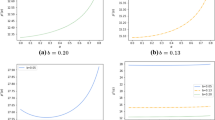Abstract
Modeling the manufacturer as a newsvendor, in this paper we study the ordering decisions of a loss-averse newsvendor with supply and demand uncertainties. Using the stylized newsvendor models, we analyse several key issues, including the effect of the newsvendor’s loss aversion, the effect of demand uncertainty, and the effect of supply uncertainty on the decision maker’s optimal decision under the procurement model, in which the decision maker only pays for the actual quantity received. Through our analysis, we find the following facts: the optimal order quantity decreases with respect to the degree of loss-aversion; the supply uncertainty induces the decision maker to order more than that in a deterministic environment; a stochastically larger demand always results in a larger order quantity and a larger expected utility; the optimal expected utility decreases in the demand volatility while the optimal order quantity may increase or decrease. Moreover, with numerical experiments, we demonstrate that the supply risk negatively affects the utility more than the demand risk does.





Similar content being viewed by others
References
Agrawal V and Seshadri S (2000). Impact of uncertainty and risk aversion on price and order quantity in the newsvendor problem. Manufacturing & Service Operations Management 2 (4): 410–423.
Burke GJ, Carrillo JE and Vakharia AJ (2009). Sourcing decisions with stochastic supplier reliability and stochastic demand. Production and Operations Management 18 (4): 475–484.
Camerer C, Babcock L, Loewenstein G and Thaler RH (1997). Labor supply of New York City cab drivers: One day at a time. Quarterly Journal of Economics 112 (2): 407–442.
Chen J, Zhao X and Zhou Y (2012). A periodic-review inventory system with a capacitated backup supplier for mitigating supply disruptions. European Journal of Operational Research 219 (2): 312–323.
Cho SH and Tang CS (2013). Advance selling in a supply chain under uncertain supply and demand. Manufacturing & Service Operations Management 15 (2): 305–319.
Choi TM and Chiu CH (2012a). Mean-downside-risk and mean-variance newsvendor models: Implications for sustainable fashion retailing. International Journal of Production Economics 135 (2): 552–560.
Choi TM and Chiu CH (2012b). Risk Analysis in Stochastic Supply Chains. Vol. 178. Springer-Verlag: New York.
Deng XX, Xie JX and Xiong HC (2013). Manufacturer-retailer contracting with asymmetric information on retailer’s degree of loss aversion. International Journal of Production Economics 142 (2): 372–380.
Eeckhoudt L, Gollier C and Schlesinger H (1995). The risk-averse (and prudent) newsboy. Management Science 41 (5): 786–794.
Gallego G and Moon I (1993). The distribution free newsboy problem: Review and extensions. Journal of the Operational Research Society 44 (8): 825–834.
Gerchak Y and Henig MI (1994). A flexible conceptualization of random yield and its implications for source selection. Proc. First Conf. ORSA Tech.Section on Manufacturing Management. Carnegie Mellon University, Pittsburgh, PA, 133–139.
Guler M and Bilgic T (2009). On coordinating an assembly system under random yield and random demand. European Journal of Operational Research 196 (1): 342–350.
Gupta D and Cooper WL (2005). Stochastic comparisons in production yield management. Operations Research 53 (2): 377–384.
He Y and Zhao X (2012). Coordination in multi-echelon supply chain under supply and demand uncertainty. International Journal of Production Economics 139 (1): 106–115.
He YJ and Zhang J (2008). Random yield risk sharing in a two-level supply chain. International Journal of Production Economics 112 (2): 769–781.
He YJ and Zhang J (2010). Random yield supply chain with a yield dependent secondary market. European Journal of Operational Research 206 (1): 221–230.
Hernig M and Gerchak Y (1990). The structure of periodic review policies in the presence of variable yield. Operations Research 38 (4): 634–643.
Hou J, Zeng AZ and Zhao L (2010). Coordination with a backup supplier through buy-back contract under supply disruption. Transportation Research Part E: Logistics and Transportation Review 46 (6): 881–895.
Hu XX, Gurnani H and Wang L (2013). Managing risk of supply disruptions: Incentives for capacity restoration. Production and Operations Management 22 (1): 137–150.
Jörnsten K, Nonås SL, Sandal L and Ubøe J (2012). Transfer of risk in the newsvendor model with discrete demand. Omega 40 (3): 404–414.
Kahn JA (1992). Why is production more volatile than sales? Theory and evidence on the stockout-avoidance motive for inventory holding. Quarterly Journal of Economics 107 (2): 481–510.
Kahneman D and Tversky A (1979). Prospect theory: An analysis of decision under risk. Econometrica 47 (2): 263–239.
Keren B (2009). The single-period inventory problem: Extension to random yield from the perspective of the supply chain. Omega 37 (4): 801–810.
Khouja M (1996). A note on the newsboy problem with an emergency supply option. Journal of Operational Research Society 47 (12): 1530–1534.
Kleindorfer P and Saad G (2005). Managing disruption risks in supply chains. Production and Operations Management 14 (1): 53–68.
Lee H and Lodree EJ (2010). Modeling customer impatience in a newsboy problem with time-sensitive shortages. European Journal of Operational Research 205 (3): 595–603.
Li Q and Zheng S (2006). Joint inventory replenishment and pricing control for systems with uncertain yield and demand. Operations Research 54 (4): 696–705.
Li X, Li YJ and Cai XQ (2012). A note on the random yield from the perspective of the supply chain. Omega 40 (5): 503–680.
Liu SX, So KC and Zhang FQ (2010). Effect of supply reliability in a retail setting with joint marketing and inventory decision. Manufacturing & Service Operations Management 12 (1): 19–32.
Liu W, Song SJ and Wu C (2013). Impact of loss aversion on the newsvendor game with product substitution. International Journal of Production Economics 141 (1): 352–359.
Ma L (2008). Loss-averse newsvendor problem with general profit target. International Journal of Information and Decision Sciences 1 (2): 145–163.
Ma L, Zhao YX, Xue WL, Yan H and Cheng TCE (2012). Loss-averse newsvendor model with two ordering opportunities and market information updating. International Journal of Production Economics 140 (2): 912–921.
Porteus EL (2002). Foundations of Stochastic Inventory Theory. Stanford University Press: San Francisco.
Schweitzer ME and Cachon GP (2000). Decision bias in the newsvendor problem with a known demand distribution: Experimental evidence. Management Science 46 (3): 404–420.
Shaked M and Shanthikumar JG (2007). Stochastic Orders. Springer-Verlag: New York.
Shen HC, Pang Z and Cheng TCE (2011). The component procurement problem for the loss-averse manufacturer with spot purchase. International Journal of Production Economics 132 (1): 146–153.
Tang CS (2006). Perspectives in supply chain risk management. International Journal of Production Economics 103 (2): 451–488.
Tang Y and Kouvelis P (2011). Supplier diversification strategies in the presence of yield uncertainty and buyer competition. Manufacturing & Service Operations Management 13 (4): 439–451.
Vakharia AJ and Yenipazarli A (2008). Managing supply chain disruptions. Foundations and Trends? In Technology, Information and Operations Management 2 (4): 243–325.
Wang CX (2010). The loss-averse newsvendor game. International Journal of Production Economics 124 (2): 448–452.
Wang CX and Webster S (2007). Channel coordination for a supply chain with a risk-neutral manufacturer and a loss-averse retailer. Decision Sciences 38 (3): 361–389.
Wang CX and Webster S (2009). The loss-averse newsvendor problem. Omega: The International Journal of Management Science 37 (1): 93–105.
Wei Y and Choi TM (2010). Mean–variance analysis of supply chains under wholesale pricing and profit sharing schemes. European Journal of Operational Research 204 (2): 255–262.
Xu H (2010). Managing production and procurement through option contracts in supply chains with random yield. International Journal of Production Economics 126 (2): 306–313.
Xu M, Chen Y and Xu X (2010). The effect of demand uncertainty in a price-setting newsvendor model. European Journal of Operational Research 207 (2): 946–957.
Xu M and Lu Y (2013). The effect of supply uncertainty in price-setting newsvendor models. European Journal of Operational Research 227 (3): 423–433.
Yano C and Lee HL (1995). Lot sizing with random yields: A review. Operations Research 43 (2): 311–334.
Acknowledgements
The authors thank the editor and the referees for their constructive comments. This research is partially supported by the National Natural Science Foundation of China (NSFC) (Nos. 71001073, 71101028, 71301023, 71371052, 71390333, 71471118), the Humanities and Social Sciences Foundation of Ministry of Education of China (Nos. 13YJC630197, 14YJC630096), the Program for New Century Excellent Talents in University (NCET-13-0733), the Distinguished University Young Scholar Program of Guangdong Province (No. Yq2013140), the Basic Research Foundation (Natural Science) of Jiangsu Province (No. BK20130582), the Beijing Natural Science Foundation (9143020), the Fundamental Research Funds for the Central Universities in UIBE (14JQ02), and the Program for Innovative Research Team in UIBE
Author information
Authors and Affiliations
Corresponding author
Rights and permissions
About this article
Cite this article
Ma, L., Xue, W., Zhao, Y. et al. Loss-averse newsvendor problem with supply risk. J Oper Res Soc 67, 214–228 (2016). https://doi.org/10.1057/jors.2015.22
Received:
Accepted:
Published:
Issue Date:
DOI: https://doi.org/10.1057/jors.2015.22




